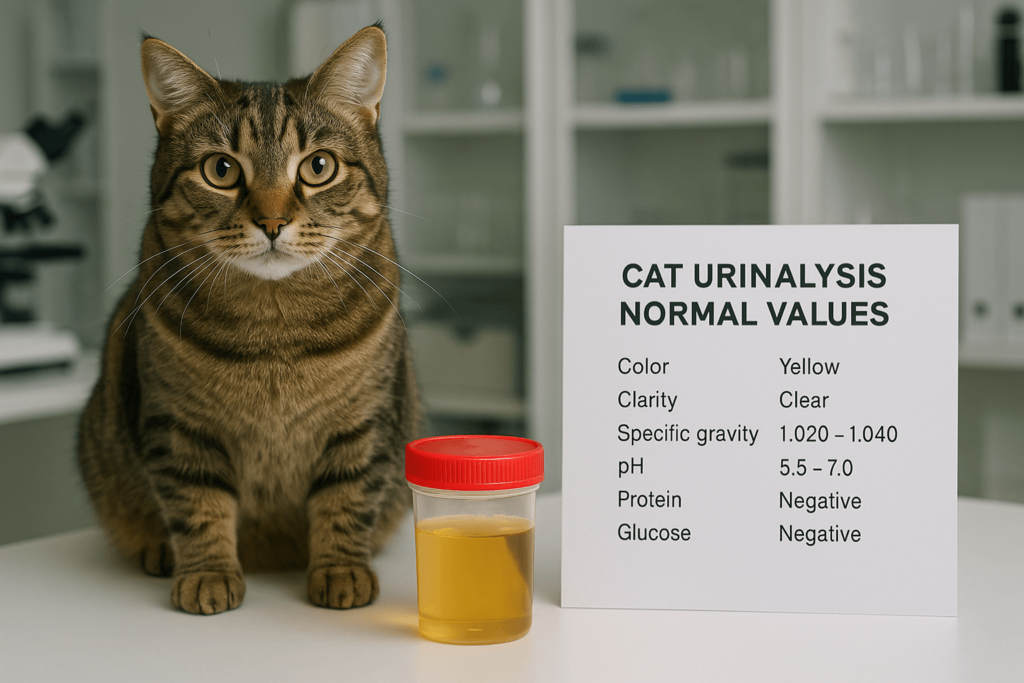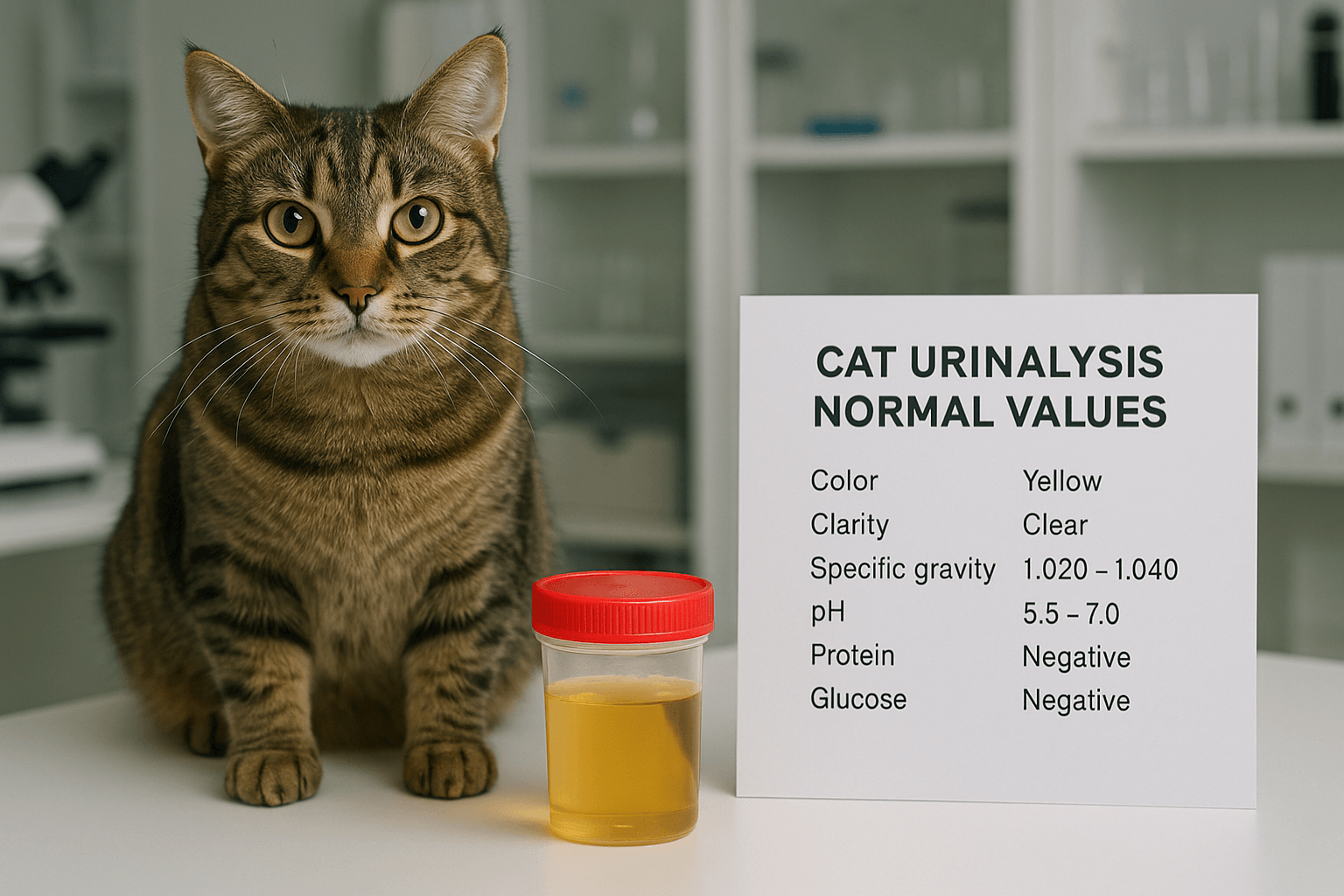Cat Urinalysis Normal Values: What Every Cat Owner Should Know
A cat’s urine is more than just waste—it’s a window into their internal health. When your vet recommends a urinalysis, they’re not just checking for “something wrong.” They’re reading a detailed biological report that can reveal kidney disease, diabetes, infections, or even stress long before symptoms appear. Understanding normal cat urinalysis values isn’t just for vets—it’s essential knowledge for every cat owner who wants to catch problems early and give their feline the best possible care.
Why a Urinalysis Is Non-Negotiable for Cat Health
A routine blood test tells part of the story. A urinalysis tells the whole truth. For cats, who are masters at hiding illness, this test is often the first clue to serious disease. Here’s why it matters:
Early Detection of Kidney Disease:
Cats are prone to chronic kidney disease (CKD), which often shows no signs until 75% of kidney function is lost—urinalysis catches it early.Identification of Urinary Tract Infections:
Bacteria, white blood cells, or blood in urine signal infection—even if your cat isn’t straining to pee.Detection of Diabetes Mellitus:
Glucose in urine is a red flag for high blood sugar, often the earliest sign of feline diabetes.Assessment of Urine Concentration (Specific Gravity):
This measures how well your cat’s kidneys are conserving water—a key indicator of renal health.Revealing Crystal Formation or Bladder Stones:
Crystals in urine can lead to life-threatening blockages, especially in male cats.
A urinalysis is not optional for senior cats, overweight cats, or those with a history of urinary issues. It’s a preventive lifeline.

The Core Components of a Feline Urinalysis Explained
A complete urinalysis evaluates physical, chemical, and microscopic properties. Knowing what’s “normal” helps you understand your vet’s findings—and ask the right questions.
Color:
Normal cat urine is pale yellow to amber. Dark yellow may mean dehydration; cloudy or red urine signals infection or blood.Clarity:
Clear or slightly cloudy is normal. Turbid (milky) urine suggests infection, crystals, or inflammation.Specific Gravity (SG):
Normal range: 1.015–1.060. High SG means concentrated urine (good kidney function); low SG suggests poor concentration (possible kidney disease).pH Level:
Normal range: 6.0–6.5. Slightly acidic is ideal. Too alkaline (above 7.0) increases risk of struvite crystals.Protein:
Trace or negative is normal. Significant protein suggests kidney damage, infection, or inflammation.
These values don’t exist in isolation. Your vet interprets them together—with context from your cat’s age, diet, and symptoms.
Check this guide 👉Hydrogen Peroxide for Cat Urine: Best 7 Expert Tips!
Check this guide 👉Understanding Kidney Stones in Cat Urine: Best 7 Tips!
Check this guide 👉Understanding Alkalinity in Cat Urine: Best 7 Expert Tips!
| Parameter | Normal Range for Cats |
|---|---|
| Color | Pale yellow to amber |
| Clarity | Clear to slightly cloudy |
| Specific Gravity (SG) | 1.015 – 1.060 |
| pH | 6.0 – 6.5 |
| Protein | Trace or negative |
What Abnormal Results Might Mean
Seeing an abnormal value doesn’t mean your cat is sick—but it does mean you need to dig deeper. Here’s what common deviations signal:
High Specific Gravity (>1.060):
Could indicate dehydration, fever, or early kidney stress. Offer fresh water and monitor.Low Specific Gravity (<1.015):
Suggests kidneys can’t concentrate urine—classic sign of chronic kidney disease, especially in older cats.Glucose Positive:
Not normal in cats. Often means diabetes, but can also occur with extreme stress (transient glucosuria).Blood in Urine (Hematuria):
May indicate bladder infection, stones, trauma, or feline idiopathic cystitis (FIC)—a stress-related condition.pH Above 7.0:
Alkaline urine increases risk of struvite crystals. Common in cats fed dry food or with urinary tract infections.
Always pair urinalysis results with clinical signs. A single abnormal value needs context—not panic.
How Diet and Hydration Influence Urinalysis Results
Your cat’s food and water intake directly shape their urine. What they eat affects everything from pH to crystal formation.
Wet Food Promotes Dilute Urine:
High moisture content helps maintain healthy specific gravity and flushes out crystals.Dry Food Can Lead to Concentrated Urine:
Low water intake increases risk of crystal formation and urinary blockages.Fish-Based Diets Raise pH:
Diets high in fish or seafood can make urine more alkaline, encouraging struvite crystals.Prescription Diets Alter Urine Chemistry:
Therapeutic diets for CKD or urinary health are formulated to adjust pH and mineral levels.Dehydration Skews All Results:
A cat who hasn’t drunk enough may show falsely high specific gravity and concentrated minerals.
If your cat eats only dry food, consider adding water to their meals or using a pet fountain. Hydration is the silent hero of urinary health.
When to Request a Urinalysis for Your Cat
Don’t wait for emergencies. Schedule urinalysis proactively based on risk factors.
Cats Over 7 Years Old:
Annual urinalysis is recommended to screen for early kidney disease.Cats with History of FLUTD or Blockages:
Biannual testing is often advised to monitor recurrence risk.Increased Thirst or Urination:
A classic sign of diabetes, kidney disease, or hyperthyroidism.Straining to Urinate or Frequent Litter Box Visits:
Even without visible blood, this could signal FIC or infection.Unexplained Weight Loss or Lethargy:
Often paired with urinary changes in chronic illness.
A urinalysis takes minutes. A missed diagnosis can cost you months—or your cat’s life.
Common Myths About Cat Urinalysis Debunked
Misinformation leads to delayed care. Let’s clear up the confusion.
Myth: “If my cat pees normally, their urine is fine.”
Cats with early kidney disease often urinate normally—until it’s too late. Urinalysis detects problems before symptoms appear.Myth: “Only sick cats need urinalysis.”
Healthy cats benefit from baseline testing. It’s the best way to track changes over time.Myth: “I can tell by smell or color alone.”
While dark urine or odor can hint at problems, many serious conditions show no visible signs.Myth: “Stress makes urinalysis unreliable.”
Stress can cause transient glucose or blood—but vets know how to interpret these patterns.Myth: “A normal urinalysis means no kidney disease.”
Early-stage kidney disease may show normal values. Blood tests (like SDMA) are needed for full assessment.
Trust the lab—not your instincts.
How to Collect a Cat Urine Sample at Home
Many owners worry about collecting urine. It’s easier than you think—with the right tools.
Use Non-Absorbent Litter:
Special litter (like Kit for Cats or Dr. Elsey’s Precious Cat Ultra) lets urine pool for easy collection.Clean the Litter Box Thoroughly:
Wash with water only—no soap or disinfectants that can contaminate the sample.Collect Within 1–2 Hours:
Urine degrades quickly. Refrigerate if you can’t get to the vet immediately.Use a Clean, Sterile Container:
Your vet will provide one—or use a clean, sealable plastic container.Label Clearly:
Include your cat’s name, date, and time of collection.
If your cat refuses to use non-absorbent litter, ask your vet about cystocentesis—a quick, safe procedure to collect urine directly from the bladder.
FAQ: Cat Urinalysis Normal Values
What does “trace protein” mean in a cat’s urinalysis?
Trace protein is normal in cats. It means a tiny, non-concerning amount is present. Significant protein (1+, 2+) requires follow-up.
Can stress cause glucose in my cat’s urine?
Yes. Stress-induced glucosuria is common in cats during vet visits. If glucose is found, your vet may repeat the test at home or check blood glucose levels.
Is a low specific gravity always a sign of kidney disease?
Not always. It can also occur with overhydration, certain medications, or adrenal disorders. Context matters.
How often should I get my cat’s urine tested?
Healthy adult cats: every 1–2 years. Senior cats (7+): annually. Cats with urinary history: every 6 months.
Can I use a human urine test strip on my cat?
No. Human strips aren’t calibrated for feline urine chemistry and can give false readings.
Listen to the Urine—It Speaks Before Your Cat Can
Your cat won’t tell you they’re in pain. They won’t complain about their kidneys or their bladder. But their urine? It speaks volumes. Every drop carries a story—about hydration, about stress, about aging, about silent disease.
A normal urinalysis isn’t just a checkmark on a form. It’s peace of mind.
An abnormal one isn’t a diagnosis—it’s a doorway.
Canned Pumpkin for Cat Diarrhea: Best 7 Expert Tips! Natural remedy to firm stools, soothe upset bellies, and support gut health safely.
Can a Cat Give You Scabies? Best 7 Expert Tips! Discover the truth about feline mites, human skin risks, and how to protect yourself—without panic.
Cat Flea vs Human Flea: Best 7 Expert Tips! Discover the truth about bites, species, and how to eliminate infestations for good.
Weird Cat Behaviors: Best 7 Expert Tips! Discover why cats do strange things—and how to understand, not punish, their instincts for a happier home.





